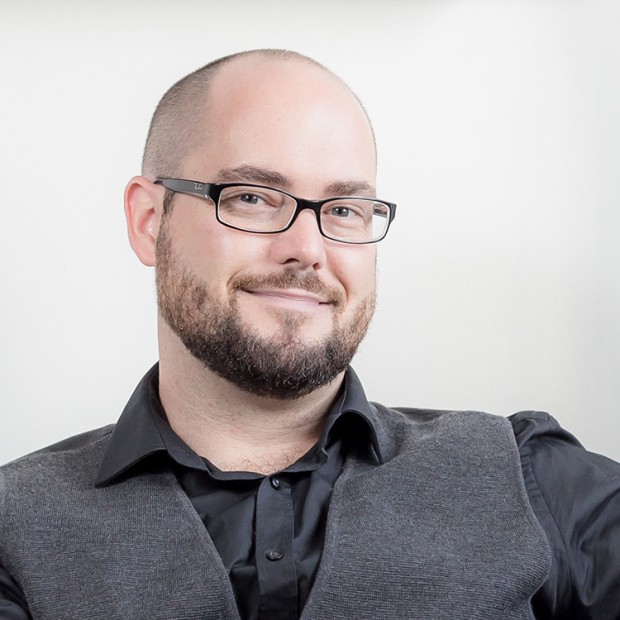Der kanadische Fotokünstler Cory Stevens lebte über zwei Jahre in München, wo wir ihn auch kennengelernt haben. Nun zieht er zurück in seine Heimatstadt Vancouver. Wir trafen ihn an einem sonnigen Morgen am Münchener Gärtnerplatz und sprachen über Abschied und den spannenden Neubeginn, über die Kunstszene in Kanada und seine abstrakten Architekturfotografien.
You are actually from Canada, then you moved to Munich. Are there any advantages the Munich art scene offers you compared to the art scene in canada?
I guess it somewhat depends on the scene you’re involved with.
The great thing about art, no matter where you are, is that it’s generally available to everyone – and that it often attracts a wide range of people – from curious pedestrians, to regular supporters, to die-hard scenesters.
The scene in Munich, I feel, is fairly comparable to that in Vancouver – though better supported. Munich, to me, has a huge number of art and gallery spaces – which host frequent public events, and generate lots of interest – whereas sometimes I feel that the art scene in Vancouver is either mainstream or underground, without an accessible ‚mid-level‘ culture. Government and private funding in Canada is also generally low. Add geography into the mix, and the opportunities for westcoast artists are pretty restricted when compared to Germany, or even the EU in general. That said, I’ve been away for over two years, and lots can change in a young city like Vancouver – and I’m looking forward to rediscovering my own city…
Are there some kind of characteristics which are typical for your work and your photography?
I think that my style is – and will continue to be – evolving, as my perspective of the world changes with time. But generally, I think that my work can be characterized as being strict, modern, clean, minimal, geometric, muted, and focused more on form than function. I purposely try to avoid including people in my work, even though my subject matter primarily features subjects and environments that are man-made. I think that contrast is both alienating and inviting – as you are indirectly asked to look at man, without physically seeing him.
Your images show almost entirely architecture. Do you notice at the first sight when a monument might be a good image?
That depends. Sometimes you can walk past a building a million times before you really notice it – and other times, a first glimpse can stop you in your tracks.
One of the main reasons why I take photographs is simply to take the time to really see – to look at things in a way that I normally wouldn’t.
Photography allows me to explore architecture visually, spatially – to look at buildings and urban environments both as a whole, and as a series of individual elements. Because modern architecture is so connected to design, math, and science – I’m constantly drawn to buildings that showcase new construction methods, make aesthetically bold statements, or reveal something unique about how we visualize the man-made landscape.
How did you get the idea to take architectural elements out of their original enviroment and to compose them in this kaleidoscopic way?
The idea for the kaleidoscopic effect was largely organic – a matter of taking interesting elements, isolating them, and reproducing and reorganizing them into something both simple and complicated, natural and yet entirely mechanical.
In the end, I let curiosity produce these works – and was surprised at how they came out.
Obviously, you edit the images after taking the picture. How does this work?
After photographing a particular building – focusing on a certain element, be it a facade, corner, angle, peak, or detail – I would process the file in Lightroom to achieve a particular look. After that in use photoshop to isolate the architectural element that I want to use – removing it from its background. The foundation piece would then, generally, be sliced vertically – usually along a natural line or spine found on the building. That sliced piece would then be duplicated and flipped – to create a mirror – before being merged to form a new, symmetrical shape. This new shape forms the basis for the rest of the work – as it’s repeatedly duplicated, rotated, merged, and blended – until it reaches its completed state, as a single object formed from many identical pieces.
Now you are leaving Germany to turn back to Canada. Do you think a relocation will influence your work as photographer due to the new enviroment and influences?
I have no doubt about that. Aside from the challenges of having to move to another country – even if it’s your own – I feel that, once settled, there will be many new opportunities in this new landscape. Even though Vancouver’s my home, I will be seeing and experiencing it with new eyes – so I look forward to how I interpret the city after being away for a while. Plus, being able to speak the language will also assist me in being able to engage deeper in the artistic community – especially now that I’m ready to start sharing and promoting my work more actively.
Lieber Cory, wir wünschen Dir alles Gute für Deinen Neustart in Vancouver!
Arbeiten von Cory bei Pablo & Paul findest Du hier:




